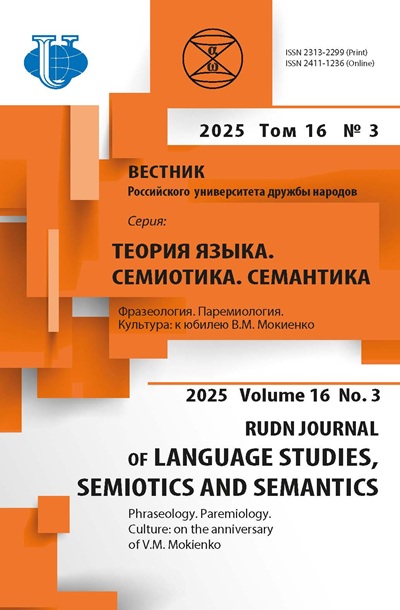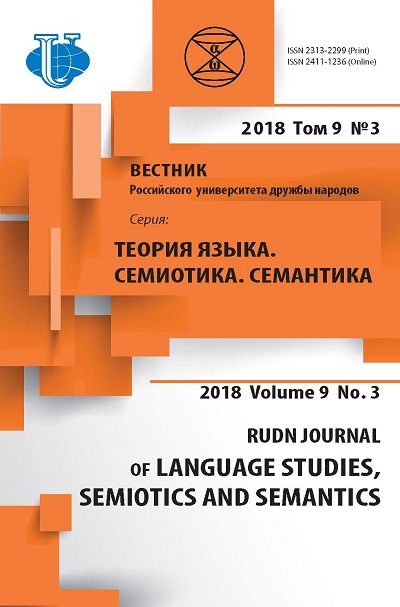ОТОНИМНЫЕ ПРАГМАТОНИМЫ С НАЦИОНАЛЬНО-КУЛЬТУРНЫМ КОМПОНЕНТОМ В РОССИЙСКОЙ РЕКЛАМЕ
- Авторы: Омельяненко В.А.1
-
Учреждения:
- Российский университет дружбы народов
- Выпуск: Том 9, № 3 (2018)
- Страницы: 712-728
- Раздел: НАУКА 21.0
- URL: https://journals.rudn.ru/semiotics-semantics/article/view/19435
- DOI: https://doi.org/10.22363/2313-2299-2018-9-3-712-728
- ID: 19435
Цитировать
Полный текст
Аннотация
В статье анализируются отонимные прагматонимы с национально-культурным компонентом в лингвокультурологическом и коммуникативно-прагматическом аспекте. Подобные примеры встречаются преимущественно в названиях торговых марок продуктов питания отечественного производства. Отонимные способы образования «коммерческих имен» называются трансонимизацией , которая заключается в переходе онима из одного подразряда имени собственного в другой. При анализе материала, полученного методом сплошной выборки, применялся комплекс различных методов, в том числе метод лингвокультурологического (лингвострановедческого) комментирования и интроспективный подход, заключающийся в том, что у самих носителей языка есть какие-то представления о национальной маркированности тех или иных единиц своего языка вне сопоставления с другими языками. Методология исследования основывается на классических обобщающих работах, посвященных проблемам ономастики, в частности - словесным товарным знакам, а также на современных исследованиях, представляющих отдельные аспекты функционирования «рекламных имен» (чаще прагматонимов и эргонимов). Выявлены наиболее типичные онимные источники, от которых они образуются, среди которых антропонимы (фамилии, имена, отчества, клички животных), разные виды топонимов (названия географических объектов). Как показал анализ, в современном рекламном пространстве наиболее употребительными являются отфиктонимные прагматонимы, которые представлены прецедентными именами. Популярность их объясняется лингвокультурологической ценностью. Анализируются также различные приемы языковой игры в наименованиях торговых марок, которые, как правило, являются креативными , то есть обусловленными каким-то намерением. Отонимные прагматонимы широко употребляются для формирования обобщенного положительного образа отечественного товара, который выступает как неотъемлемая часть благосостояния всей страны. Функция анализируемых единиц позволяет номинатору охарактеризовать особенность товара, указать производителя, местоположение производства, обозначить целевую аудиторию его потребления, а также перевести незнакомый продукт из категории «чужой» в категорию «свой». Обращение к патриотическим чувствам потребителя используется с коммерческой целью как средство речевого воздействия, с одной стороны, и как важное средство продвижения отечественных товаров для укрепления российского рынка.
Об авторах
Виктория Александровна Омельяненко
Российский университет дружбы народов
Автор, ответственный за переписку.
Email: omelianenko_va@rudn.university
ассистент кафедры русского языка № 2 факультета русского языка и общеобразовательных дисциплин РУДН, аспирант кафедры общего и русского языкознания филологического факультета РУДН
ул. Миклухо-Маклая, 6, Москва, Россия, 117198Список литературы
- Ремчукова Е.Н., Евстратова С.Б. Актуализация национально-культурных компонентов в русскоязычной прессе Эстонии // Acta Slavica Estonica. V. 2014. С. 182-192.
- Мегамагнат. Портал о торговле в России. Режим доступа: http://www.megamagnat.ru/ (дата обращения: 01.06.18).
- Хоффманн Э. Еда в Лабиринте ценностей // В кн.: Еда по-русски в зеркале языка. Москва: РГГУ: Ин-т рус. яз. им. В.В. Виноградова, 2013. С. 177-264.
- Подольская Н.В. Словарь русской ономастической терминологии. М.: Наука, 1978.
- Semprini A. La marque // Presses Universitaires de France. 1995.
- Крюкова И.В. Имена собственные в современной российской рекламе // Рекламный дискурс и рекламный текст / Науч. ред. Т.Н. Колокольцева. М.: ФЛИНТА; Наука, 2016. С. 261-278.
- Турута И.И. Эргонимы и прагматонимы: сходство и отличие // Вісник Дніпропетровського університету. Серія: Мовознавство. 2016. Т. 24. Вип. 11. С. 159-170.
- Мордвинова Н.Г. Словесные товарные знаки алкогольных напитков (на материале русского, чувашского, французского, итальянского, испанского, немецкого и английского языков): автореф. дис.. канд. филол. наук: Чуваш. гос. ун-т им. И.Н. Ульянова. Чебоксары, 2008.
- Баранов А.Н., Добровольский Д.О. Основы фразеологии (краткий курс). М.: Флинта, 2013.
- Отин Е.С Топонимическая метонимия: Вид связи «гидроним - ойконим». Избранные работы. М.: МФГО СССР, 1980. С. 106-121.
- Отин Е.С. Словарь коннотативных собственных имен. Донецк: Юго-Восток, 2010.
- Супрун В.И. Ономастическое поле русского языка и его художественно-эстетический потенциал. В.: Перемена, 2000.
- Соболева Т.А., Суперанская А.В. Товарные знаки. М.: Наука, 1986.
- Крюкова И.В. Рекламное имя: от изобретения до прецедентности. В.: Перемена, 2004.
- Кара-Мурза Е.С. Новые имена. Коммерческое имя как риторическая и маркетологическая проблема // М.В. Ломоносов и современные стилистика и риторика / науч. ред. И.Б. Александрова, В.В. Славкин. М.: Флинта, Наука, 2008. С. 282-303.
- Ремчукова Е.Н., Соколова Т.П., Махиянова Л.Р. Проблемы нейминга: новые русские урбанонимы в лингвокреативном аспекте // Гуманитарные, социально-экономические и общественные науки. 2015. no 9. С. 328-333.
- Медведева Е.В. Рекламная коммуникация. М.: Изд-во ЛКИ, 2008.
- Ремчукова Е.Н., Страхова А.В. Рекламное «зазеркалье» России и Франции: Лингвокреативный и гендерный аспекты. М.: ЛЕНАНД, 2016.
- Вежбицкая А. Язык. Культура. Познание / пер. с англ.; отв. ред. М.А. Кронгауз. М.: Русские словари, 1996.
- Феоктистова Л.А., Горяев С.О. Об «Иванах» в наименованиях алкогольных напитков // Ономастика Поволжья. Материалы XV Международной научной конференции. Арзамас, 2016. С. 380-384.
- Золтан Н. «Пиво с мужским характером»: пиво и его локальные значения // Сибирские исторические исследования. 2014. no 2. С. 83-94.
- Большой толковый словарь русского языка / под ред. С.А. Кузнецова. Санкт-Петербург: Норинт, 2000.
- Ремчукова Е.Н., Омельяненко В.А. Языковые средства формирования имиджа России в современной рекламе // Вестник Российского университета дружбы народов. Серия: Теория языка. Семиотика. Семантика. 2017. Т. 8. no 2. С. 341-349.
- Литовкина А.М. Концепт «Сибирь» и его эволюция в русской языковой картине мира: от «Сибирских летописей до публикаций В.Г. Распутина»: дис.. канд. филол. наук: Иркутский гос.пед. ун-т. Иркутск, 2008.
- Терских М.В., Малёнова Е.Д. Медиаобраз сибирского региона: лингвокогнитивное моделирование. Омск: ЛИТЕРА, 2015.
- Союз российских пивоваров. Режим доступа: http://www.beerunion.ru/ (дата обращения: 01.06.18).
- KIAN. Компания Режим доступа: http://kian.ru/agency/ (дата обращения: 01.06.18)
- Кира и Рубен Каньян Водка: так просто, так сложно. Режим доступа: http://www.usconsult.ru/b_015.html (дата обращения: 01.06.18)
- Сметанина С.И. Медиа-текст в системе культуры. СПб.: Изд-во Михайлова В.А, 2002.
- Омельяненко В.А. Фольклорные традиции в современной рекламе / Язык: категории, функции, речевое действие // Сб. материалов X юбилейной межд. Конф. к 75-летию В.С. Борисова. Коломна: МГОСГИ, 2017. C. 143-146.
- Ремчукова Е.Н. Лингвокреативные составляющие современных СМИ на фоне активных языковых процессов // Humaniora: Lingua Russica. Труды по русской и славянской филологии. Лингвистика ХII. Активные процессы в русском языке диаспоры и метрополии. Тарту, 2009. С. 303-316.
- Ремчукова Е.Н., Махиянова Л.Р. Лексико-грамматические механизмы лингвокреативности в сфере городской номинации // Вестник РУДН. Серия: Теория языка. Семиотика. Семантика. 2015. no 2. С. 132-142.
- Омельяненко В.А. Семантическая категория «свой круг» в национально-ориентированной рекламе // Русский язык в поликультурном мире. Сб. науч. статей. В 2-х т. Том 1. Симферополь: ИТ «АРИАЛ», 2017а. C. 318-324.
Дополнительные файлы












